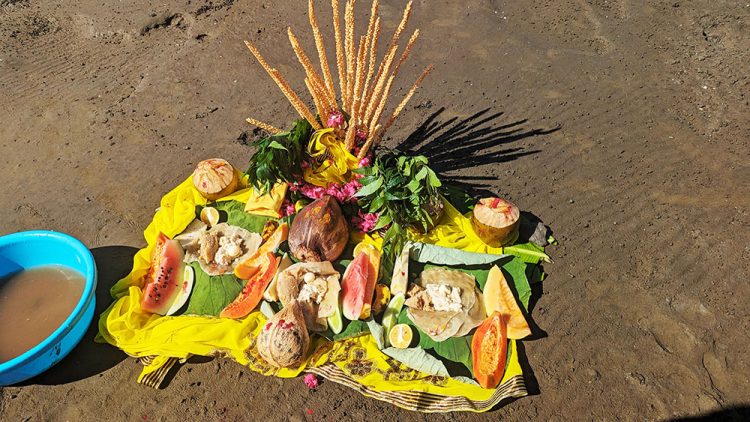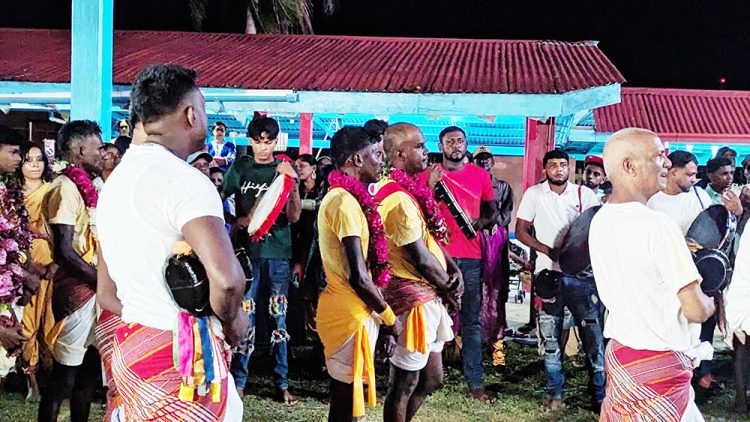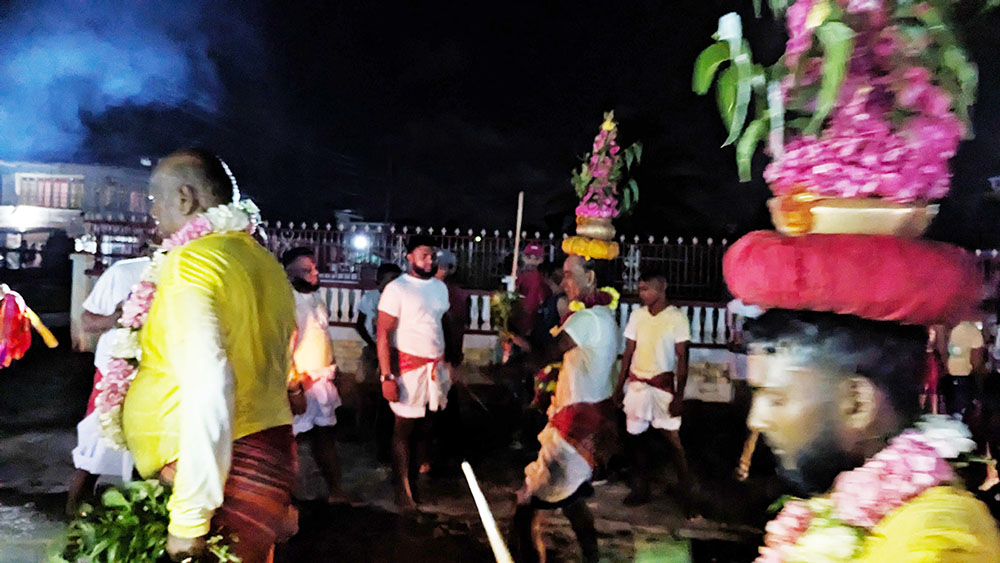By Haimdat Sawh
Down in the verdant heart of Berbice, Guyana, nestled between sprawling sugarcane fields and winding rivers, lies Whim Village. This village is a sanctuary of spirituality and a reservoir of rich Indo-Madrassi and Tamil culture in the Caribbean. Each year, Whim Mariamman Kovil hosts the Whim Mariamman Temple Village Puja, a major celebration deeply cherished by the community. This puja was celebrated on April 26 to 29. This vibrant festival not only showcases the village’s strong religious convictions but also draws people from around the globe, celebrating faith and communal ties under the brilliant Corentyne sky. It highlights the universal appeal and welcoming nature of this spiritual gathering, making it a significant event that embodies the cultural richness and spiritual depth of the Indo-Madrassi Guyanese diaspora.
The Whim Mariamman Temple Puja traces its roots back to the early 20th century when Tamil labourers from Madras were brought to British Guiana under indentureship. These pioneers brought their deep reverence for Mariamman, the goddess of rain, fertility, and disease, embedding their traditions deep in the heart of Berbice. The first temple, established in the 1930s, became the hub for these annual celebrations, reflecting the community’s strong will and dedication to preserve their culture.

Over the years, the temple has evolved with significant developments, including the construction of the main building in 1972, each phase mirroring the community’s growth and deepening devotion. A week before the Puja, the temple buzzes with activity as many men, boys and ladies from the village prepare the site—cleaning, repairing, and decorating it with flags and lights, while the murties of Mariamman and other deities are carefully adorned. This preparation is not just about physical readiness but also spiritual purification, ensuring the ambiance matches the spiritual significance of the event.
From the heart of Berbice, the lineage of Pujaris at Whim Village Temple tells a story of unwavering devotion and cultural pride that resonates deeply within the Indo-Madrassi community in Guyana and the wider Caribbean. It began with the legendary Chinappa Veerana, known as Thata Headman, who led from 1950 to 1972, followed by Permaul Appiah, or Peter Jogie, until about 1985. Lawen Appan then took up the mantle until Harvey Hardeen, stepped in from 1997 to present.

Throughout these years, others like Gunraj, Vernon Permaul, Ernest Permaul, Madray Kistama, and Ramsammy Renganaidum have also given their time to lead. Moreover, leaders like Peter Permaul and Peter Buchanan have significantly transformed our temple, using personal funds to convert structures from wood to concrete and add new features inspired by distant lands like Mauritius and Fiji, under the watchful eye of Veeramootoo Madray, or Mootoo boy, who supervised the build for free.
Honours go to Changana Eliah for his honest and dedicated service that keeps our spiritual haven shipshape. This wholehearted commitment from our community not only preserves but also vividly celebrates our rich heritage, making the Whim Village Puja a must-experience spectacle of rituals, music, and communal joy, weaving a living tapestry of history and tradition.
In the April of each year the Whim Mariamman Temple Puja in Guyana bursts into life with vibrant processions and devout prayers, highlighted by the soul-stirring Mariamman Thuthi sung during a three-night celebration. This Tamil hymn, honouring the goddess Mariyamman, is central to the festivities as chosen devotees carry the kargam through the village, creating a spiritual spectacle.
This year, the prayer’s deeply symbolic lyrics like “Mayi, Maga mayi, mani manthara sekhariye” and “Narayanaar thangai ammal nalla muthu mariyare” were led by a lady for the first time, marking a historic shift towards gender inclusivity. Her presence as a singer not only honoured her but also represented a significant step towards gender equality in the village’s spiritual practices, despite mixed feelings among some conservative community members. This inclusive approach transformed the village atmosphere into a divine festivity, resonating with peace and sanctity.
The Whim is a vibrant spectacle, where the Indo-Caribbean spirit shines bright with days filled with prayers, hymns, and stunning dance performances that blend classical and folk styles, all without the fire-walking seen elsewhere. This year’s festival was extraordinary, featuring the historic inclusion of a lovely lady among the uddakkay singers during the Mariyamman Thuthi, a deeply revered hymn praising Mariyamma.
This event, spanning three lively nights, marked a significant move towards gender inclusivity in our sacred practices. The community’s response was mixed, reflecting the tension between tradition and progress. Yet, the integration of a female voice in the traditionally male chorus brought a fresh dynamic to the event, enhancing the communal spirit.
The temple serves as both a spiritual anchor and a cultural bastion, preserving Tamil heritage amidst the diverse Caribbean backdrop, blending Dravidian folk religion with elements of Hinduism, local Obeah, and Christian iconography. Over the decades, the temple’s architecture has evolved, with new additions in the 1960s and 1970s to support the growing flock and the rich rituals performed here. However, recent conversations among community members reflect varied opinions on the mandir’s direction, the role of women, and the need for wider participation from both locals and the diaspora.
The community is at a crossroads, seeking leadership that can bridge divisions and foster unity, with a focus on respectful and inclusive practices. This push towards inclusivity, echoed by modern thinkers, signifies a progressive shift that could redefine this community and others for the better.
The Whim Mariannsha is a riveting event that captures the essence of our Madrassi heritage in Guyana and the Caribbean, showcasing the strong spiritual and cultural bonds that sustain our community. Conversations among the folks reveal a mix of views about the temple’s future, the role of women, and how much our local villagers and the diaspora from the US should contribute.
There’s real talk about the leadership and who gets to join in, crucial for charting the temple’s path forward. Yet, there’s a growing wave among the younger generation, advocating for more inclusive participation, marking a shift towards a modern and open vibe. This vibe is seen in the respectful ways of our youth, indicating a generational shift towards a more inclusive approach.
Pujari Harvey’s commitment shines as he invests personally his time and resources in the temple’s longevity and the spiritual well-being of our community. His efforts have not only maintained the temple as a sturdy structure but have also bolstered its role as the spiritual heart of Whim Village, reinforcing a sense of continuity and sacredness central to our identity.
Attending the Puja, witnessing the unyielding faith and the lively discussions, highlights the temple’s significance and the power of faith amidst modern pressures. It’s a story of survival, identity, and transformation—a must-experience for everyone, especially those of Madrassi descent, inspiring us to uphold our rich traditions while embracing progressive changes.
The Whim Mariamman Temple Village Puja, more than just a festival, is the vibrant heartbeat of our community in Guyana, encapsulating the enduring spirit and cultural vitality of the Indo-Madrassi diaspora. Every year, as the Puja closes, it leaves us charged with a renewed sense of culture and faith, bridging the past and present, and blending the sacred with the everyday.
It’s a vivid celebration that highlights our triumphs and struggles to keep our rich heritage alive amidst the rapid changes of the modern world. This event not only reinforces our cultural identity but also acts as a spiritual sanctuary, drawing on the strength of our traditions to inspire future generations.
As the drums fade and the vibrant processions end, we carry forward the lessons learned and blessings received, reminded of the unifying power of our traditions in the heart of Guyana. A must-experience for everyone, especially those of Madrassi descent, the Whim Mariamman Temple Village Puja stands as a testament to the beauty of cultural preservation and the strength of our community spirit.

